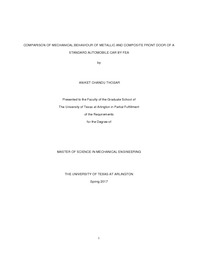
ATTENTION: The works hosted here are being migrated to a new repository that will consolidate resources, improve discoverability, and better show UTA's research impact on the global community. We will update authors as the migration progresses. Please see MavMatrix for more information.
Show simple item record
| dc.contributor.advisor | Beyle, Andrey | |
| dc.contributor.advisor | Nomura, Seiichi | |
| dc.creator | Thosar, Aniket Chandu | |
| dc.date.accessioned | 2017-07-03T15:48:50Z | |
| dc.date.available | 2017-07-03T15:48:50Z | |
| dc.date.created | 2017-05 | |
| dc.date.issued | 2017-05-12 | |
| dc.date.submitted | May 2017 | |
| dc.identifier.uri | http://hdl.handle.net/10106/26829 | |
| dc.description.abstract | With the advent of technology, materials have advanced many folds; one such technical revelation has been Fiber-reinforced Composite Materials. Composite materials have two major advantages, among many others: improved strength and stiffness, especially compared to other materials on a unit weight basis and low density with ease of manufacturing. These advantages have led to new aeronautical, automobile and marine designs that are radical departures from past efforts based on conventional materials.
This paper focusses on a comparative study between Aluminum Alloys, Manganese alloys, structural steel, Composite materials and investigates the static and dynamic behaviors for a composite front door of vehicle. There were successful attempts to use composite doors in automotive industry but the analysis was done by traditional methods ignoring many details of the design. Now many firms are investigating replacement of traditional door by composite ones.
The objective of this study was to find the cause of failure of the unidirectional composite layers in varying cross sections of the door. Finite element method is used to calculate Static and dynamic behavior under possible impact using ANSYS software to simulate real time operating conditions (speed, etc.). Anisotropic material properties and fiber architecture are adjusted to the acting stresses. The car door is modeled using SOLIDWORKS for the various materials like reinforced fiberglass epoxy, Kevlar epoxy and Carbon epoxy which are of great interest to the transportation industry. It is observed that compared to conventional materials, composites show lower stresses in all for the same boundary and loading conditions and much higher safety factor.
Thus, retaining stiffness of the door like existing one but increasing strength significantly compared to persisting design increasing car safety. Composite doors are lighter achieving higher fuel efficiency and energy conservation. It will lead to higher survivability of humans in the case of collision. All these effects can be achieved, when the cost of the door will be bigger less than 2 times or total car cost increase less than 10%. | |
| dc.format.mimetype | application/pdf | |
| dc.language.iso | en_US | |
| dc.subject | FEA | |
| dc.subject | Composite door | |
| dc.subject | ANSYS | |
| dc.subject | SolidWorks | |
| dc.title | COMPARISON OF MECHANICAL BEHAVIOUR OF METALLIC AND COMPOSITE FRONT DOOR OF A STANDARD AUTOMOBILE CAR BY FEA | |
| dc.type | Thesis | |
| dc.degree.department | Mechanical and Aerospace Engineering | |
| dc.degree.name | Master of Science in Mechanical Engineering | |
| dc.date.updated | 2017-07-03T15:49:53Z | |
| thesis.degree.department | Mechanical and Aerospace Engineering | |
| thesis.degree.grantor | The University of Texas at Arlington | |
| thesis.degree.level | Masters | |
| thesis.degree.name | Master of Science in Mechanical Engineering | |
| dc.type.material | text | |
| dc.creator.orcid | 0000-0003-1862-1246 | |
Files in this item
- Name:
- THOSAR-THESIS-2017.pdf
- Size:
- 2.900Mb
- Format:
- PDF
This item appears in the following Collection(s)
Show simple item record


